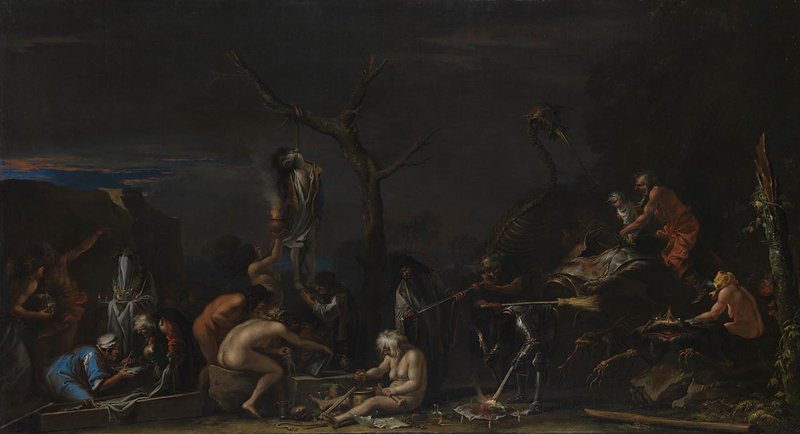The Wicked Witch of Art History
Andy Warhol, The Witch, 1981. © Andy Warhol
In the recently released Wicked film, Elphaba, the Wicked Witch of the West, belts out, “As someone told me lately: Everyone deserves a chance to fly!” But when it comes to witches in art history, not everyone shared this sentiment. The various depictions of witches in Western art range from satanic rituals to sensual scenes of seduction, and elicits a fascinating discussion of how women who behaved out of the ordinary, spiritual women, sexual women, women who read, and older women were perceived throughout history and today.
While the Wicked film is a wonderful portrayal of female friendships and an homage to standing up for what you believe in, it also examines “wickedness.” When discussing Elphaba’s journey to becoming “wicked,” Glinda raises the question: “Are people born wicked? Or do they have wickedness thrust upon them?” Indeed, it is the marginalization and admonishment of her differences that force Elphaba into becoming a “witch.” Well, that and her pointy black hat and the fact that she flies on a broomstick.
Some of the most influential depictions for how we imagine witches today began with the German painter and printmaker Albrecht Dürer. In Dürer’s engraving The Witch (ca. 1500), a horrifying and haggard witch rides backwards on a goat (the symbol of the devil) and holds a broomstick, while four putti surround her holding symbols of witchcraft. Another engraving, The Four Witches (ca. 1497), shows three witches initiating a young woman into their circle. While their beauty sets them apart from the usual grotesque depictions of witches, the horned demon and scattered bones and skull at their feet allude to magic and evil.
Fear, repulsion, and superstition ruled the Holy Roman Empire regarding witchcraft. Witches were believed to have made a pact with the devil in exchange for powers. Church politics, family feuds, and hysteria plunged people into a frenzy that scapegoated certain individuals. From this period until the 17th century, accused women and occasionally men and children were wrongfully imprisoned, executed, burned, and hung.
Dürer’s gruesome and evocative iconography prevailed and this legacy can be seen in 17th century witch depictions like Salvator Rosa’s Witches at their Incantations (1646). Not all portrayals were dark and satanic scenes, however. In a classical allusion, Italian artist Giovanni Benedetto Castiglione illustrates the sorceress Circe transforming men into animals. In Witches’ Sabbath (1606), Flemish artist Frans Francken II represents the traditional conception of witches oscillating between beauty and horror.
Salvator Rosa, Witches at their Incantations, ca. 1646, The National Gallery, London
Frans Francken II, Witches’ Sabbath, 1606. Victoria & Albert Museum, London
A shift in the representation of witches occurred after 1750. The Age of Enlightenment reigned in the previous era of superstition and people largely stopped believing in the magical creatures. Witchcraft in Europe began to be decriminalized and art historical imagery of witches became less grotesque. This change is reflected in Francisco Goya’s Los Caprichos series, where witches were used as a metaphor for corruption and as digs at superstition and paranoia. The witch figure was used as an allegory, as a literature subject, and became more beautiful and sensual, as seen in the work of the Pre-Raphaelites and John William Waterhouse’s The Magic Circle (1886), which showcases a barefoot enchantress circling a cauldron, evoking more allure than threat.
Francisco de Goya, Witches’ Flight , ca. 1798, Museo del Prado
John William Waterhouse, The Magic Circle, 1886
Leonora Carrington, The Giantess, 1950
As we move into the modern age, women artists reclaimed ideas and imagery surrounding witchcraft. Spiritualist artists Georgiana Houghton—a medium—and Swedish artist and mystic Hilma af Klint created among the first abstract paintings, a new visual expression inspired by spiritual beliefs and guidance, séances, and symbolism. Leonora Carrington’s work, often labelled as Surrealist, commonly invokes conversations of witchcraft and magic for its transformative and mystical quality.
From Circe in Homer’s Odyssey, to Shakespeare’s three witches in Macbeth, to Elphaba herself, depictions of witches in Western history transcend the black pointy hat and broomstick. From its origin as a grotesque scapegoat for superstition and misogyny, to the singing green protagonist of our cinema screen, the witch of art history is a complex, storied figure. Dare I say, “unusually and exceedingly peculiar and altogether quite impossible to describe”...







